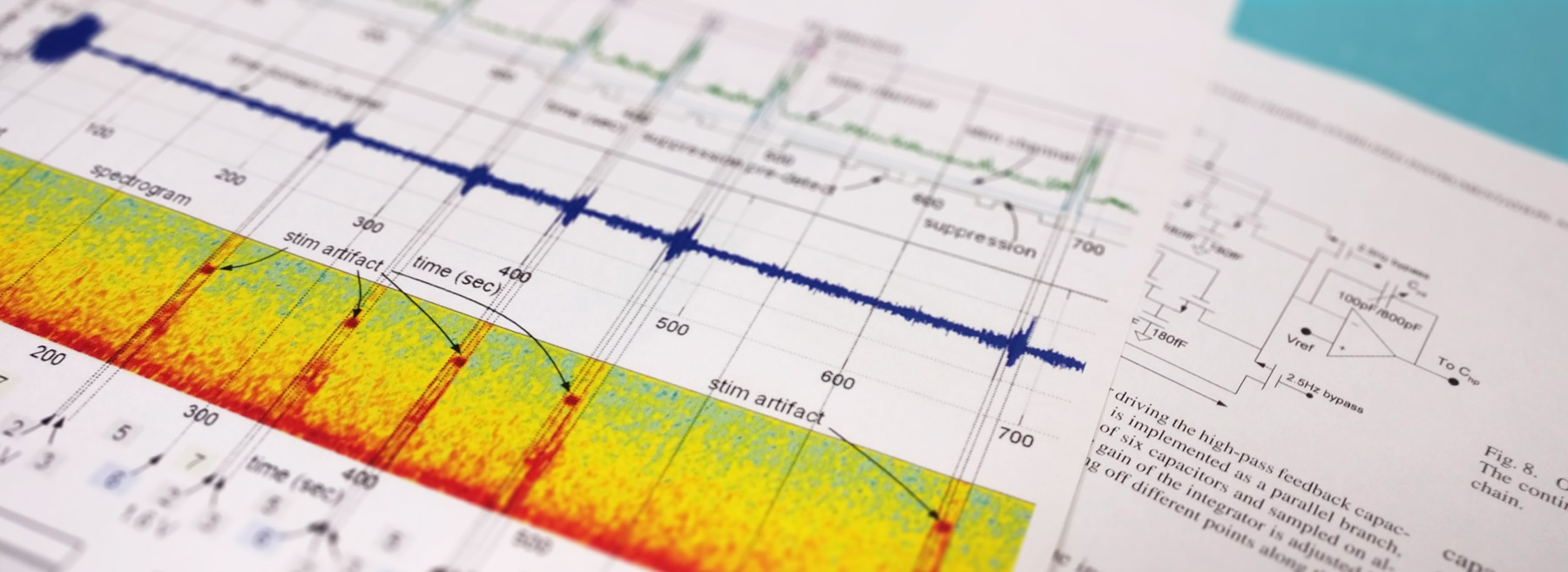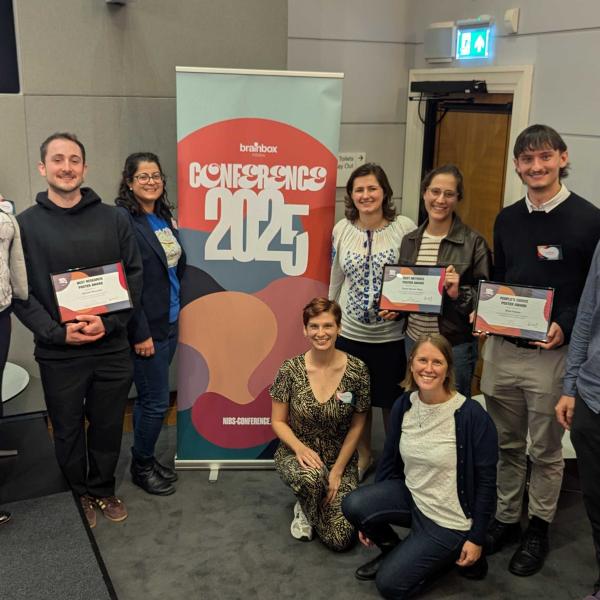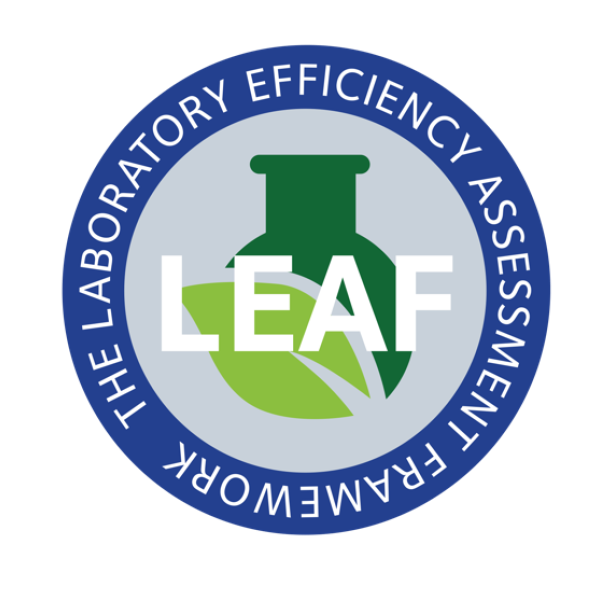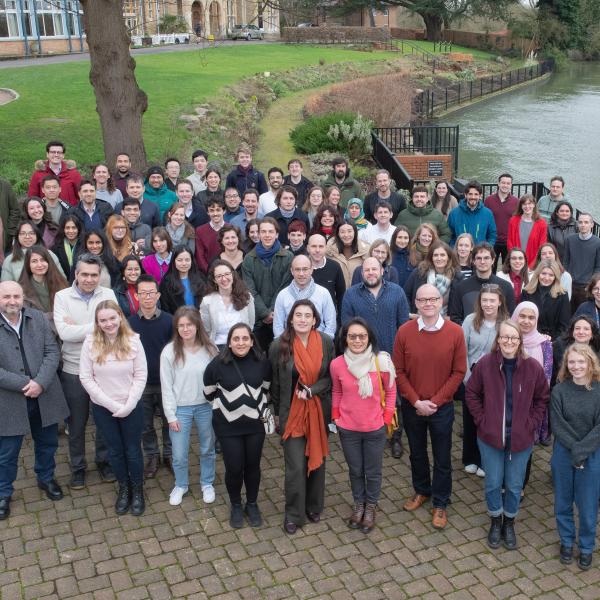Denison Group
The physiologic controls team explores novel technology to interact with the nervous system, with a goal to restore function in people with neurological and neurodegenerative disorders. Our translational engineering efforts include the creation of novel research tools for neuroscience discovery, and the application of the resulting discoveries towards developing better disease treatments.
When treating neurological disorders, doctors have generally relied on drug discoveries. Yet the significant personal and societal costs incurred by such disorders, and current state of the pharma pipeline, motivate alternative approaches to treatment.
Bioelectronics work directly with the body's own nervous system to monitor brain signals and, as needed, modulate the electrical activity within nerves to alleviate symptoms of diseases. Examples of bioelectronic therapies for the nervous system include brain modulation for Parkinson’s and epilepsy, spinal cord stimulation for chronic pain, and sacral nerve stimulation for incontinence. Despite clinical success in treating symptoms of diseases like Parkinson's, existing bioelectronic systems have several limitations that arguably limit their adoption. For example, currently a skilled clinician is required to configure the implant, and the system's output is relatively inflexible to the rapidly changing and reactive activity of the nervous system.
The microelectronic basis and digital programmability of bioelectronic systems means that there is huge potential for flexibility in both research and future medical device design. Emerging technology offers the possibility of building restorative neural systems, which are adaptable and programmable for various diseases, as well as specifically for individuals. The codes used to programme the systems can be modified as scientific understanding of the brain evolves, and also be used to rapidly respond to physiological fluctuations within the body. But to fully realize this potential, we first need a better understanding of how the brain functions and responds to bioelectronic interventions.
To this end, our research explores new integrated bioelectronic hardware and software platforms for investigating foundational clinical neuroscience and improved treatments for neurological disorders. We partner with industry and clinical collaborators on both tool development and proof-of-concept testing (see highlighted publications). A common focus in on translating areas of neurotechnology that provide a high return on investment for the healthcare system (improvement in patient outcomes/cost for deployment). These prototypes often leverage established clinical pathways and commercial systems with a targeted technical upgrade enabling novel functionality. Examples include adding new stimulation pattern capability to an existing tonic stimulator to enable rehabilitation research, and adding sensing and algorithm circuitry to a deep brain stimulator to prototype bi-directional brain-machine-interfaces for treating brain disorders. The diversity of these applications reflects both the breadth of neurological disorders, and the potential of bioelectronic systems to address them.
DYNEUMO -- Implantable Bioelectronic Systems: Our team is co-developing with industry partners "instrumented medical devices" that enable clinical neuroscience discovery and prototyping of adaptive algorithms across timescales from milliseconds (e.g. respond to field-potentials) to hours and days (e.g. modulate circadian and ultradian rhythms). We are currently supporting pilot trials in multiple system atrophy, epilepsy, and chronic pain.
MAGNETO -- "Digital" Transcranial Magnetic Stimulation: Our team is co-developing with industry partners and colleagues in Engineering Science a new method for delivering non-invasive brain stimulation. Our technique will enable greater flexibility in patterns and pulse shapes compared to predicate designs.
MORPHEUS -- Sleep: Our international collaboration (Oxford, Surrey, Mayo Clinic, UCSF), funded by DARPA, is exploring the application of targeted brain stimulation for modulating sleep rhythms.
OPENMIND -- Platform Science: The OpenMind consortium (UCSF, Mayo Clinic, Brown University, and Oxford) is developing and managing neuroscience toolkits for instrumented medical devices.
- Bioelectronic systems design including micropower mixed-signal electronics, tissue-electrode interfaces, and algorithms
- Power electronics for megawatt pulse generation for transcranial brain stimulation
- Machine learning methods for assessment of large datasets enabled with our scientific instruments
- Mathematical models for assisting in algorithm design
- Quality management systems (e.g. 13485) and design controls for meeting regulatory requirements
We are committed to fostering an inclusive work environment that celebrates diversity and promotes equal opportunity within our group and the wider MRC BNDU.
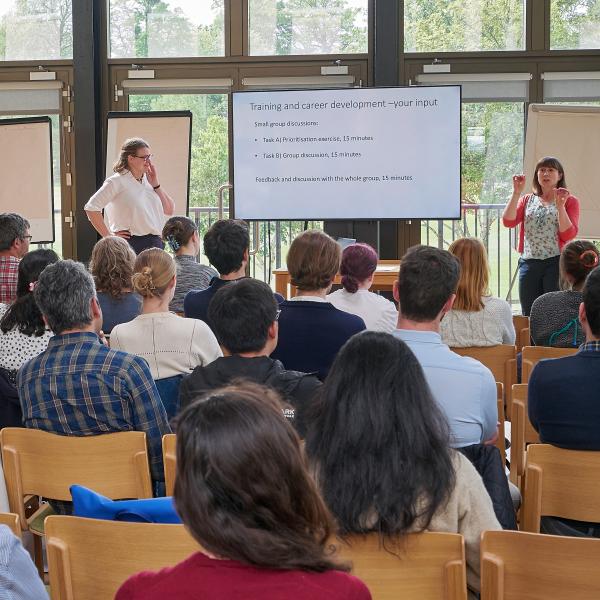
Mary Muers (far right) moderates an interactive session about training and career development opportunities.
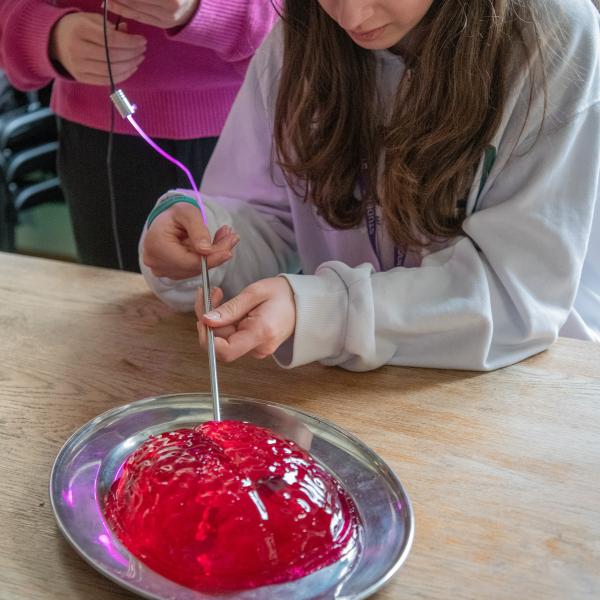
A visiting school pupil tries their hand at implanting a dummy stimulation electrode in a jelly brain!
Studentships
Project
Interacting with memory dynamics in the human brain
Studies in rodents have uncovered how neural oscillations shape memory, revealing causal links between brain rhythms and behaviour. In contrast, studying memory in humans presents unique challenges. Researchers often face limited access to detailed brain recordings, fewer opportunities to apply advanced analytical techniques, and only emerging use of real-time methods to influence brain activity during memory tasks. These factors make it more difficult to explore the underlying network dynamics as precisely as in animal models.
The aim of this PhD studentship is to uncover the mechanisms by which oscillatory brain dynamics support memory in humans. The project will integrate high-density intracranial recordings, closed-loop stimulation, and multivariate analytical frameworks to monitor and manipulate hippocampal and connected neural circuits with high spatiotemporal precision. By leveraging these innovative techniques in human participants, the research will explore how medial temporal lobe oscillations reorganise during memory processes and develop targeted interventions to enhance memory and treat related disorders.
The project will take place in the Brain Network Dynamics Unit of the Nuffield Department of Clinical Neurosciences and in the Medical Research Council Centre of Research Excellence in Restorative Neural Dynamics (MRC CoRE RND). Students will benefit from the extensive interdisciplinary skills training and personalised career development opportunities available within the Unit and the MRC CoRE RND. Students will receive specialised training in their areas of project research (see below) as well as, for example, in the translation and commercialisation of research, best practice in Open Science, and how to effectively involve and engage patients and the public with research.
The project will build on a collaboration with neurologists and neurosurgeons at the University Hospital of Toulouse, France, where the Dupret laboratory is collaborating with Dr. Leila Reddy to conduct brain-wide intracranial tetrode recordings in human participants engaged in memory and inferential reasoning tasks. The studentship holder will harness cutting-edge methods for identifying, monitoring, and manipulating network oscillations and neuronal ensembles. You will receive advanced training in several of the following techniques: brain network electrophysiology, closed-loop systems, behavioural assays, and advanced data analysis.
This four-year Ph.D. (D.Phil.) studentship offers three years of full-time tuition fees at the Home rate, and four years of non-taxable stipend at the full-time UKRI rate (including any uplifts announced). Both Home students and International students are eligible to receive this funding package. Please see further details about MRC/UKRI studentships and updated guidance regarding Home and International eligibility. Successful offer-holders who have applied by the December deadline may also be considered for other University of Oxford scholarships.
Interested candidates should possess, or expect to receive, a 1st class or upper 2nd class degree (or equivalent) in a related scientific discipline such as biological or physical sciences, engineering, mathematics, medicine, or computer science. Previous experience in neuroscience research is desirable. The ability to interact in French with human participants is also highly valuable, given the collaborative nature of the project with clinical teams in France.
Candidates must contact the lead project supervisor before submitting an application. To find out more about this studentship, the research project, and the application process, please contact Professor David Dupret by email on david.dupret@bndu.ox.ac.uk.
To be considered for this studentship, please submit an application for admission to the D.Phil. in Clinical Neurosciences at the Nuffield Department of Clinical Neurosciences (course code RD_CU1), following the guidance for applications to this course. On the application form, in the section headed ‘Departmental Studentship Applications’, please indicate that you are applying for a studentship and enter the reference code “26NDCN01MRC” into the funding tab.
The closing date for applications is 12.00 midday UK time on Tuesday 2nd December 2025.
Opening in November 2025, the MRC CoRE RND is an exciting team science enterprise that is focused on harnessing the moment-to-moment interactions between nerve cells (‘neural dynamics’) to transform medical device-based therapy for brain conditions. The MRC CoRE RND incorporates discovery research and translational research aligned to empirical neuroscience, computational neuroscience, experimental medicine, and biomedical engineering. The MRC CoRE RND is exceptionally collaborative, involving partners in academia, neurotechnology industry, research charities, and clinical services. It will champion values supporting a positive research culture.
Supervisors
Applications are invited from both Home students and International students to join a multidisciplinary team of researchers studying the brain network electrophysiology of memory processes. This studentship is available from the start of academic year 2026/27, is for 4 years, and will be co-supervised by Professor David Dupret and Professor Tim Denison at the MRC Centre of Research Excellence in Restorative Neural Dynamics.
Project
Phase-locked stimulation for modulating brain rhythms during wakefulness and sleep in Parkinson’s
In Parkinson’s disease, abnormal brain rhythms - such as elevated beta waves and disrupted slow waves - contribute to movement and sleep problems. Phase-locked Deep Brain Stimulation holds promise for correcting these brain activity patterns by timing stimulation to specific phases of rhythms. This studentship project will explore how phase-locked Deep Brain Stimulation can improve motor function and sleep in people with Parkinson’s, moving toward personalised brain stimulation therapies.
The aim of this PhD project is to determine how modulating abnormal brain rhythms with phase-locked Deep Brain Stimulation (DBS) can improve movement and sleep symptoms in people with Parkinson’s. The research will combine real-time brain signal processing with closed-loop stimulation to target beta rhythms during wakefulness and slow-wave activity during sleep. The studentship holder will work with people with Parkinson’s who have already received DBS, develop stimulation protocols using a computer-in-the-loop system, and help build software interfaces for implantable devices. Through collaboration with clinical and engineering teams, the project seeks to advance understanding of how brain rhythms relate to behaviour and how neuromodulation therapies can be better personalised.
The project will take place in the Brain Network Dynamics Unit of the Nuffield Department of Clinical Neurosciences and in the Medical Research Council Centre of Research Excellence in Restorative Neural Dynamics (MRC CoRE RND). Students will benefit from the extensive interdisciplinary skills training and personalised career development opportunities available within the Unit and the MRC CoRE RND. Students will receive specialised training in their areas of project research (see below) as well as, for example, in the translation and commercialisation of research, best practice in Open Science, and how to effectively involve and engage patients and the public with research.
You will receive advanced training in human neurophysiology, including recording and real-time processing of signals from within and outside the brain. You will gain hands-on experience with closed-loop brain stimulation systems and work directly with people with Parkinson’s, learning clinical research methods, behavioural testing, and sleep quantification. You will also be given opportunities to build skills in time-series analysis, machine learning, and software development for neurotechnology, including designing software interfaces for implantable devices.
This four-year Ph.D. (D.Phil.) studentship offers three years of full-time tuition fees at the Home rate, and four years of non-taxable stipend at the full-time UKRI rate (including any uplifts announced). Both Home students and International students are eligible to receive this funding package. Please see further details about MRC/UKRI studentships and updated guidance regarding Home and International eligibility. Successful offer-holders who have applied by the December deadline may also be considered for other University of Oxford scholarships.
Interested candidates should possess, or expect to receive, a 1st class or upper 2nd class degree (or equivalent) in a related scientific discipline, e.g. physical sciences, medicine, computer science, engineering or mathematics. Previous experience in neuroscience research is highly desirable.
Candidates must contact the lead project supervisor before submitting an application. To find out more about this studentship, the research project, and the application process, please contact Professor Huiling Tan by email on huiling.tan@ndcn.ox.ac.uk.
To be considered for this studentship, please submit an application for admission to the D.Phil. in Clinical Neurosciences at the Nuffield Department of Clinical Neurosciences (course code RD_CU1), following the guidance for applications to this course. On the application form, in the section headed ‘Departmental Studentship Applications’, please indicate that you are applying for a studentship and enter the reference code “26NDCN01MRC” into the funding tab.
The closing date for applications is 12.00 midday UK time on Tuesday 2nd December 2025.
Opening in November 2025, the MRC CoRE RND is an exciting team science enterprise that is focused on harnessing the moment-to-moment interactions between nerve cells (‘neural dynamics’) to transform medical device-based therapy for brain conditions. The MRC CoRE RND incorporates discovery research and translational research aligned to empirical neuroscience, computational neuroscience, experimental medicine, and biomedical engineering. The MRC CoRE RND is exceptionally collaborative, involving partners in academia, neurotechnology industry, research charities, and clinical services. It will champion values supporting a positive research culture.
Supervisors
Applications are invited from both Home students and International students to join a multidisciplinary team of researchers studying how phase-locked Deep Brain Stimulation can be used to modulate pathological brain rhythms during wakefulness and sleep in Parkinson’s disease. This studentship is available from the start of academic year 2026/27, is for 4 years, and will be co-supervised by Professor Huiling Tan, Dr Shenghong He, and Professor Tim Denison at the MRC Centre of Research Excellence in Restorative Neural Dynamics.
